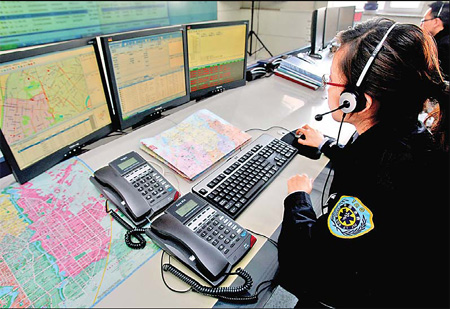Society
Getting there on time: Behind the '120' service
By He Na and Han Junhong (China Daily)
Updated: 2010-04-07 07:00
 |
Large Medium Small |
'Talking with robots'
 |
|
Hotline staff deal with callers in the control room of the Changchun Emergency Medical Center in the capital of Jilin province. [Shi Zhongwei/for China Daily] |
Paramedics are also battling a lack of training and resources, said several angry former customers, while others slammed the "cold" attitude of the 120 call center staff.
"Nurses dispatched by emergency medical centers don't even know how to take blood pressure or use oxygen bags," complained Zhang Ran in Xi'an, capital of Shaanxi province, who called 120 after her father suffered a heart attack.
"My father, who is in his 60s, was having difficulty breathing when they arrived. The nurse took out an oxygen bag but she didn't know how to connect it with the hose. Another one took his blood pressure twice and got completely different results," she said.
Concerned they were wasting time, Zhang, who lives on the fifth floor of an apartment block with no elevator, insisted the nurses take her father to the hospital - only to discover the ambulance did not have a stretcher.
"I had to knock on my neighbors' doors and ask them to help carry him downstairs," she said. "Luckily, my father recovered or else the emergency crew would have been to blame."
For Wang, a Beijing resident in his 50s, just calling 120 when his wife suffered a brain hemorrhage was an arduous experience. "It felt like I was talking with robots," he said. "No matter what questions I asked, they only answered with three words or just ignored me."
Xu Jianyang, director of psychology at the General Hospital of Armed Police Forces in Beijing, argued first-aid personnel are often busier than hospital staff and need to sacrifice niceties in order to speed up the rescue service.
"Paramedics face bloody scenes, and life and death emergencies every day. It is hard for ordinary people to understand their stressful workload," he said. "They may sound like they are rude and impatient, but they are trying to save time."
However, many experts did admit that most 120 emergency centers do suffer a shortage of vital resources.
"Our center has 53 ambulances and almost each one is equipped with all the necessary equipments: first-aid kit, cardiac compression pump, electrocardiograph, pacemaker, breathing machine, sputum aspirator, oxygen bomb and stretcher," said Liu at the Changchun center. "The local government has paid great attention to updating our equipment in recent years. But given the metropolitan population of almost 5 million, it is still far from enough.
"The inadequate number of staff and medical resources means sometimes we face the embarrassment of having no ambulances available."
Yao Ke, director of the eye division of the No 2 hospital affiliated with Zhejiang University, agreed and said the resources distributed nationwide to 120 emergency medical centers is uneven.
"A lack of vehicles and rudimentary facilities have heavily restricted the development of the industry," he said.
In developed areas, there is an emergency station for every three square kilometers. In rural areas, it is sometimes difficult to find one station per every 20 square kilometers.
Hangzhou, which has a population of more than five million, has just 34 ambulances at its disposal - the province of Zhejiang has 250 overall - according to Yao, who said each vehicle has been in service an average of 13 years.
"According to the 120 standard, one ambulance should serve every 50,000 to 80,000 people in an urban area, which in rural areas that increases to 100,000 to 150,000. Few city and county-level emergency centers meet the standard," he said.
In Jiashan county, Zhejiang province, the 120 center has just one ambulance, according to a Democracy and Law report, a Beijing-based newspaper. With population of 380,000, the city should have at least seven to meet the standard.







